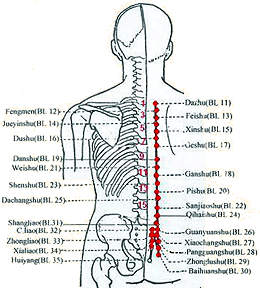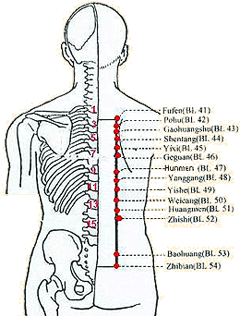The Practice of Chinese Massage Therapies
Like acupuncture and moxibustion, Chinese massage is based on theories dealing with the organs, meridians, qi (vital energy) and blood. The massage techniques work on particular meridians or acupoints and regulate the flows of the body network, creating either a local or general effect for the body.
TCM treatment follows the principles described in the Huang Di Nei Jing (The Yellow Emperor's Medicine Classic): "examining carefully the conditions of yin and yang so as to get them in a relative state of balance." Therefore:
 |
Cold states should be heated; |
 |
Heat states should be cooled; |
 |
Swellings or accumulations should be dissipated; |
 |
Pathogen invasions should be expelled; |
 |
Strains should be warmed; |
 |
Persistent leakages should be arrested; |
 |
Exhaustion should be replenished. |
Based on syndrome differentiation, massage therapists apply gentle, heavy, slow, rapid, vigorous or soft stimulations for specific conditions. For example:
 |
Light, soft and slow kneading and rubbing on particular body points are to overcome organ weakness; |
 |
Strong or forceful rubbing, scrubbing, squeezing or pressing techniques are to expel pathogens and inhibit over-functioning; |
 |
For conditions like coldness or under-functioning, relatively slow and soft rhythmical manipulations are performed for a considerable length of time, so as to promote the circulation and create warmth. |
 |
|
 |
When Bladder Meridian runs along the bilateral sides of spinal process, it divides into two branches. The sections of the meridian locate acupoints that have close relationships with inner organs and thus can specially use for regulating them. |
In a typical session, the massage is given on a table or stool with the patient wearing loose clothing. The length of a massage will be determined by the selected region(s) as well as individual responses and the therapist's technique. The number of massage sessions needed depends on the severity and type of condition, with generally acute mild muscular sprains, for example neck stiffness, being alleviated in one to three sessions, while acute lumbar sprains need three to five sessions. For chronic cases like a particular organ dysfunction, the course of treatment can last for up to three months, while the more stubborn joint problems may take longer.
Indications and Contraindications for Chinese Massage
Chinese massage therapies are widely applied to a variety of conditions, especially for traumatic injuries as well as painful diseases. If you are in doubt or under medical supervision, discuss with your doctor before embarking on massage therapy.
Indications for massage therapies:
 |
Physical injuries that are caused by direct violence or chronic strain; |
 |
Middle and late stage soft tissue injuries caused by direct violence; |
 |
Certain bone or joint diseases that lead to pain and limited movement; |
 |
Some internal functional disorders. |
Contraindications for massage therapies:
 |
Suspected fractures, strains, injuries that are accompanied with neural signs; |
 |
Tumors, tuberculosis & bone infections; |
 |
Early acute joint sprains with severe swelling; |
 |
Acute soft tissue contusions with severe swelling; |
 |
Severe heart and lung disease; |
 |
Bleeding or blood vessel disorders; |
 |
Presence of infected skin and wounds in the selected region; |
 |
Pregnancy and during menstrual period are not appropriate to stimulate the pelvic region; |
 |
Elderly people with weak constitutions or osteoporosis; |
 |
After meals, when drunk or extremely tired. |
|